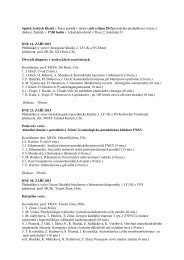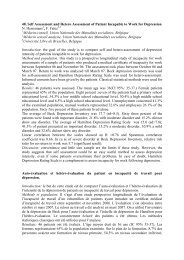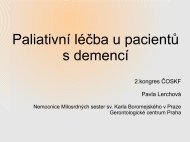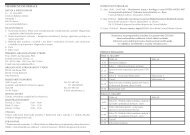ABSTRACTS â ORAL PRESENTATIONS - AMCA, spol. s r.o.
ABSTRACTS â ORAL PRESENTATIONS - AMCA, spol. s r.o.
ABSTRACTS â ORAL PRESENTATIONS - AMCA, spol. s r.o.
You also want an ePaper? Increase the reach of your titles
YUMPU automatically turns print PDFs into web optimized ePapers that Google loves.
and HistoPARK (CZ.1.07/2.3.00/20.0185). LK was supported by the European Regional<br />
Development Fund - Project FNUSA-ICRC (No. CZ.1.05/1.1.00/02.0123).<br />
References<br />
Chandel, N.S., McClintock, D.S., Feliciano, C.E., Wood, T.M., Melendez, A., Rodriguez,<br />
A.M., Schumacker, P.T.: Reactive oxygen species generated at mitochondrial complex III<br />
stabilize hypoxia-inducible factor-1α during hypoxia: a mechanism of O2 sensing. – J Biol<br />
Chem 275: 25130-25138, 2000.<br />
Finkel, T.: Signal transduction by reactive oxygen species. – J Cell Biol 194 (1): 7-15, 2011.<br />
Wang G. L., Jiang B. H., Rue E. A., Semenza G. L.: Hypoxia-inducible factor 1 is a basichelix-loop-helix-PAS<br />
heterodimer regulated by cellular O2 tension. – Proc Natl Acad Sci<br />
USA 92: 5510–5514, 1995.<br />
Wouters, B. G. and Koritzinsky, M.: Hypoxia signalling through mTOR and the unfolded<br />
protein response in cancer.: – Nat Rev Cancer. 8: 851-64, 2008.<br />
P87. ROLE OF HIF-1Α IN SELFRENEW AND DIFFERENTIATION OF NEUROSPHERES<br />
DERIVED FROM EMBRYONIC STEM CELLS<br />
Pánská V. 1 , Večeřa J. 1 , Kubala L. 2,3 , Pacherník J. 1,3<br />
1<br />
Institute of Experimental Biology, Faculty of Science, Masaryk University, Brno, Czech<br />
Republic; veronika.panska@centrum.cz<br />
2<br />
Institute of Biophysics ASCR v.v.i., Brno, Czech Republic<br />
3<br />
ICRC - CBCE, FNUSA, Brno, Czech Republic<br />
Hypoxia inducible factor 1α (HIF-1α) is a main factor which responds to hypoxia<br />
and regulates adaptation to hypoxic conditions. HIF-1α is important for stemness<br />
maintenance by stabilizing activated Notch-1 (NICD) and for maintenance of neurogenic<br />
niche by upregulating vascular endothelial grow factor (VEGF) (Gustafsson et al., 2005;<br />
Covello et al., 2004).<br />
These informations are important for our experiments with neural stem cells (NSC). We<br />
use NSCs derived from murine wt and HIF-1α deficient embryonic stem cells (ES) and<br />
NSCs dissected from embryonic brain (Hitoshi et al., 2004). We monitor influence of<br />
HIF-1α knock-out on formation, selfrenewal capacity and transition ability of NSCs by<br />
neurosphere cultivation (colony forming assay) and by screening of neural markers using<br />
qRT-PCR and WB techniques.<br />
We also use flow cytometry for confirmation of neural attributes of our NSCs and for<br />
quantifying cells with neural characteristics. In this assay we work with neural markers<br />
such as Forse-1 and Pax-6.<br />
According to our preliminary results from qRT-PCR and colony forming assay, HIF-1α<br />
supports selfrenewal of NSCs and knockout of HIF-1α enables neurospheres to express<br />
more neural markers. Moreover, gene expression of Hes1 and Hes5 transcription factors<br />
is affected by HIF-1α knockout which poits to interaction of HIF-1α and Notch pathways<br />
in selfrenewal abilities of NSC.<br />
Acknowledgements<br />
192 Analytical Cytometry VII








